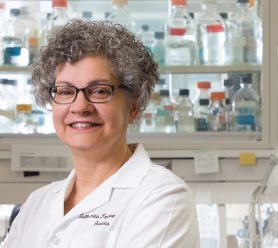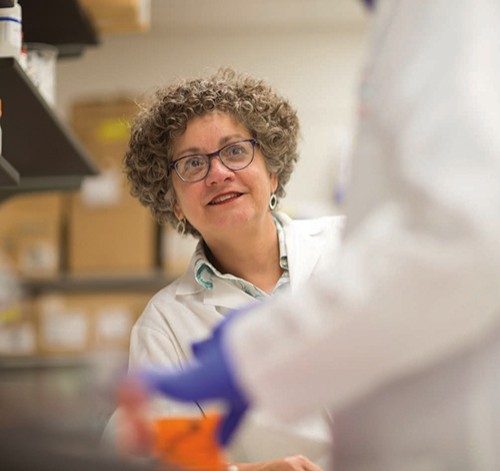Guillermina Lozano and the genetics of cancer
The MD Anderson scientist and department chair saw something in the DNA of cancer that everyone else overlooked

Shortly after arriving at MD Anderson in 1987 as a junior faculty
member, Guillermina Lozano, Ph.D., attended several
seminars hosted by the center’s biochemistry department.
The biochemists giving the presentations were studying the role of transcription factors – proteins that regulate how genes express themselves.
Lozano, a geneticist working to understand p53, a gene known to
suppress tumor
development, suddenly wondered if p53 could
itself be a transcription factor.
“I went back to my office and pulled out the sequence of p53 and said, ‘oh, here’s this negatively charged domain that could attract the transcriptional machinery and here’s this positive domain that could bind DNA.
Maybe it is a transcription factor.’ So then we planned the experiments that would test that hypothesis.”
The experiments proved the hypothesis correct and Lozano published her findings in the journal Science, establishing her reputation as one of the world’s foremost cancer researchers. In 2017, she became the sixth MD Anderson scientist elected to the National Academy of Sciences, but the first chosen for research conducted while on faculty at the institution.

The road to a career in research
The daughter of Mexican immigrants, Lozano was born and raised in East Chicago, Indiana, where her love of science was kindled by her teachers at Bishop Noll, a private Catholic high school. In her senior year, however, her family moved to McAllen, Texas, to be closer to their Mexican relatives, and Lozano was forced to adjust to a less challenging public school.
After graduating, she enrolled at nearby Pan American University (now the University of Texas-Rio Grande Valley). “I grew up in a Mexican-American culture,” she recalls. “I’m a woman. I was expected to get married and have a family, I wasn’t expected to go to college. My father only let me go to Pan American so that if my future husband ever left me, I would be able to support myself.”
After graduating from Pan American, however, Lozano was accepted into a summer program at the National Institutes of Health in Bethesda, Maryland. She had planned to become a science teacher, but her experience at the NIH set her on a new trajectory.
“It was absolutely cutting-edge research,” she says. “I loved it. I was learning so much, and I had a great mentor who I still keep in touch with. That’s when I really decided research is what I wanted to do.”
Lozano’s NIH experience led to a job offer even further afield – Munich, Germany, where she was hired as a laboratory technician at the prestigious Max Planck Institute. Although she loved working as a tech, and enjoyed the opportunity to travel around Europe, Lozano knew she wanted to become a researcher in her own right, so she returned to the U.S. and got her doctorate at Rutgers University and the University of Medicine and Dentistry of New Jersey. She then completed a postdoctoral fellowship at Princeton University under renowned cancer researcher Arnold Levine.
It was at Princeton that Lozano first began cloning and manipulating mouse DNA to study how cancers develop.
Not long after moving to Houston to join MD Anderson, her mentor Levine published a paper announcing the discovery of p53 as a tumor suppressor that regulates cell division to prevent tumors from growing. Because of its cancer-fighting abilities, p53 is sometimes called the “guardian of the genome.”
The power of p53
Lozano built on Levine’s breakthrough by establishing that p53 is a transcription factor. Her team then went on to recognize the physiological importance of two proteins, Mdm2 and Mdm4, that play a role in blocking p53 – and thus allowing tumors to grow. By manipulating these proteins, Lozano believes, clinicians may some day be able to stop cancers on the molecular level before they spread. Drug companies have developed experimental treatments based on her research, but so far they’re too toxic for use in humans.
“I think every tumor cell has to somehow dampen p53,” she explains.
“For about 90% of tumor cells, we know what the pathway is – it’s either delete p53, or neutralize it by making lots of the inhibitors Mdm2 or Mdm4. We need to discover how the other 10% undermine the p53 pathway.”
Over the years, Lozano has fielded several offers from rival cancer centers. What keeps her at MD Anderson, she says, is the synergy and collaboration of the center’s basic scientists and its clinicians. It’s the same kind of intellectual cross-fertilization that led to her insight into p53 as a transcription factor back in 1987.
“I’m not a physician, but I understand that some of the problems they encounter are problems that I can study as a basic scientist,” she says. “We wouldn’t be the number one cancer hospital without the underlying the research that drives patient care. That collaboration is what keeps me here.”

The p53 gene
This is a tumor suppressor gene, which means it inhibits unrestrained cell division and the formation of tumors. When p53 is mutated, it’s inactivated and is associated with many types of cancer such as breast, bladder, lung and ovarian, as well as cholangiocarcinoma (bile duct cancer), head and neck squamous cell carcinoma and Li-Fraumeni syndrome.
The pioneering discovery
Lozano was the first to establish p53 as a transcriptional activator of other genes. Transcription is the first step in a gene’s expression of its protein. She also showed that common p53 mutants fail to launch transcription, and discovered other proteins, Mdm2 and Mdm4, which play critical roles in inhibiting p53 activity in development and cancer.
The Lozano Lab
“The research in my lab has been focused on understanding the functional mechanisms of cancer-associated genes by generating mouse models. We have a long-standing interest in the p53 gene as the most mutated in cancer. Mutation of the p53 gene is a critical event in the elaboration of many tumors of diverse origin. The p53 protein is activated in response to DNA damage, serving as a checkpoint in the elimination or repair of cells with damaged DNA.
Alterations in components of the p53 pathway, such as amplification of the Mdm2 gene, which encodes a p53 inhibitor, also contributes to tumorigenesis. The overall goal of my laboratory is to understand the signals that regulate the p53 pathway and the consequences of expressing wild-type or mutant p53.”
The honors
Lozano was elected to the National Academy of Sciences in 2017. She is the sixth scientist from MD Anderson to be named to the academy. Others include Jim Allison, Ph.D., chair of Immunology; Craig V. Jordan, Ph.D., professor of Breast Medical Oncology; Ronald DePinho, M.D., professor of Cancer Biology; and Nancy Jenkins, Ph.D. and Neal Copeland, Ph.D., both professors of Genetics.
Lozano also is an elected fellow of the American Association for the Advancement of Science and member of the National Academy of Medicine. Her many honors include the Mattie Allen Fair Research Chair in 2004 from MD Anderson, and AACR’s Minorities in Cancer Research Jane Cooke Wright Lectureship. In April, she was awarded the President’s Leadership Award for Advancing Women and Minority Faculty at MD Anderson.

The keys to her success
Scientific curiosity
“I have always wanted to learn new things.”
A strong and supportive family: Her husband, Greg, and daughter, Rebecca
“If not for my family, I would have worked nonstop and would probably have burned out by now.”
A competitive nature
“When one of my teachers in high school said that boys were smarter than girls, I set out to prove him wrong, and I did – I had the top grade in that class all year.”
Know yourself
“To be successful in any endeavor, it is very important to know your strengths and weaknesses, and to play to your strengths.”
Strike a balance
“It is vitally important to have interests outside the laboratory.”
Lozano’s pursuits beyond research:
“I enjoy traveling with my husband. Some recent trips we’ve taken include visits to Vietnam, Cambodia, Singapore and Sedona, Arizona. This year we plan to go to Stockholm and Portugal.
I also enjoy growing orchids. I have a greenhouse and more than 50 orchids, with about 20 blooming at any one time. I also love exploring nature through hiking and bird-watching.”











